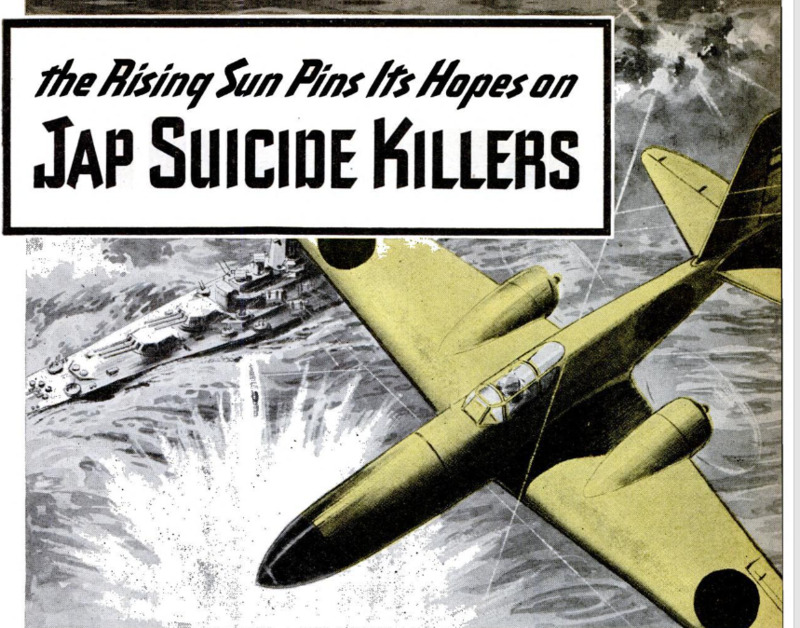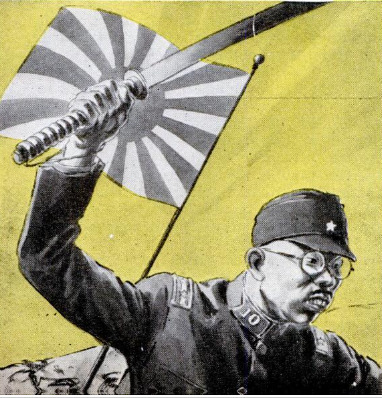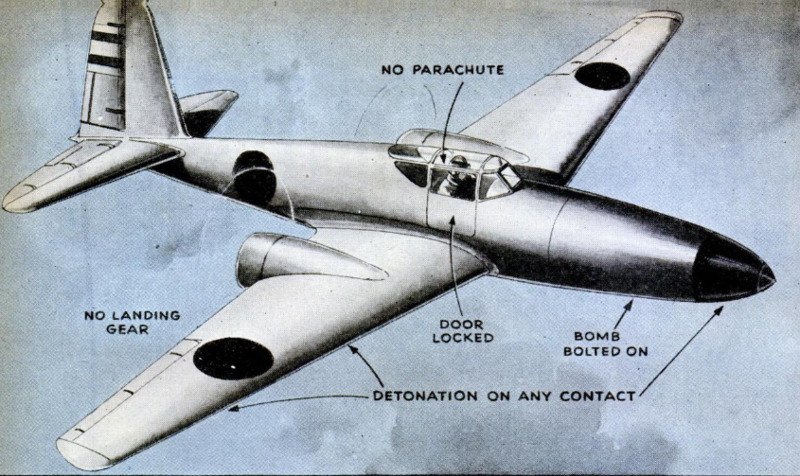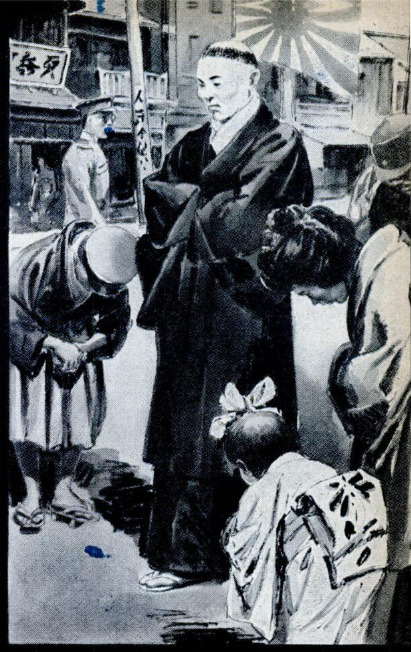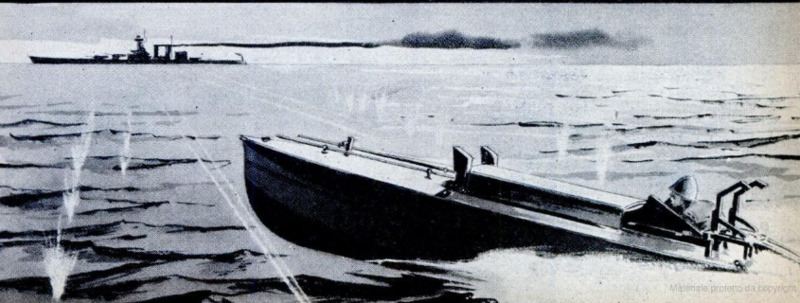-
Title (Dublin Core)
-
The rising sun pins its hopes on Jap suicide killers
-
Article Title and/or Image Caption (Dublin Core)
-
The rising sun pins its hopes on Jap suicide killers
-
extracted text (Extract Text)
-
OUT of the depths of savagery and su-
perstition the Japanese have forged a
fantastic weapon to hurl at their American
enemies by land, sea, and air. It is merely
an idea—the glorification of death in battle.
The high command of the Japanese armed
forces has taken this idea and indoctrinated
picked groups of young men with it, so that
they deliberately go out seeking suicide in
attacks on their Empire's foes.
These suicide killers are not looking for
victory. They are not trained to do the
maximum damage possible to their enemies.
Apparently they are anxious merely to die
while attacking Americans, in a spectacular
gesture of Japanese superiority. Picked
aviators with this idea come diving through
flak in an all-out effort to crash their planes
with loads of explosives on the decks of our
warships. Picked infantrymen lie camou-
flaged, hugging supplies of dynamite, in the
path of our tanks or trucks on islands such
as Iwo or Okinawa, hoping to blow them-
selves up with some American vehicle and
a few American men. Jap suicide killers in
little motorboats come dashing out of Pa-
cific harbors by night, yearning to end their
lives in a big explosion against the hull of
an American ship.
It is a strange type of warfare, judged by
Occidental standards, but a very natural de-
velopment in this Oriental people, trained
to regard hara-kiri, or ceremonial suicide,
as one of the grandest acts of which man
is capable.
It was not until Admiral of the Fleet
Chester W. Nimitz, carly in April, an-
nounced that the Japs were using suicide
pilots in an attempt to sink our ships that
the veil of censorship was ripped from this
phase of war in the Pacific, which had been
a subject for laughter and amazement
among our fighting men there for more
than six months. The Admiral denied Japa-
nese claims that their suicide killers had
sunk several of our battleships and cruisers
and major carriers,
No battleship, cruiser, or Essex-class
carrier had yet been sunk by these Nip
tactics, be said. Some of the Jap suicide
killers who failed in their objectives have
been captured. Now it can be revealed that
they were members of a “Kami-Kaze”
Corps, which takes its name from the God
of the Wind in Japanese mythology.
The Kami-Kaze flyers are pretty young—
most of them between 18 and 20. They have
been graduated from cadet schools as fight-
er pilots, and then have volunteered for
certain death in battle. They are consecrated
men. Once they have taken their vow to
die for their Emperor they are as good as
dead, and they know it. When they fly on
thelr missions they are locked into their
cockpits. The wheels of their planes drop
away automatically as they leave the
ground. Their explosive loads are so built
into the planes that they can't be jettisoned.
No Kami-Kaze pilot ever carries a para-
chute. The instant his plane comes into
contact with anything, it goes to pieces in
a big explosion and a swiftly spreading
flame, carrying the pilot to a glorious im-
mortality and—possibly—destroying some
American target.
After their graduation from cadet school,
these Kami-Kaze pilots get a six-months
special training course, and then a great
feast. The feast may last for several days.
It includes plenty of sake and the finest
foods. The prettiest geisha girls entertain
these death-dedicated airmen. The pilots
paint their faces white, simulating death's
pallor.
According to reports from China, the
Kami-Kaze flyers usually shave their heads
except for a little round patch of hair on
the top of their skulls, and there is a smaller
shaven circle within that patch. They dress
in ceremonial robes of black. During the
final days of their leave, before their fatal
mission, they walk through the streets with
hands folded across their chests. They never
smile. People meeting them bow and get
out of their way. When they start their
fatal mission, the Kami-Kaze pilots circle
the field three times, while all the personnel
of the field stand at attention till they are
out on their course.
Dispatches from Kunming, China, say
that a new suicide plane is going into mass
. production in Manchuria, which has a long
ton of explosive—2,240 pounds—built into
its nose like a torpedo war head. The pro-
peller is in the rear. It is nothing more nor
less than a flying bomb, guided by a human
being, which may prove quite as damaging
as Germany's famous V-bombs.
‘The night before the landing of American
forces in Lingayen Gulf on Luzon, I was
aboard an American destroyer. A Jap sui-
cide killer in a little motorboat came rushing
through the darkness toward the vessel in
which I was sleeping. A gunner aboard the
destroyer blew up this assailant at 100
yards’ range, and the explosion was so se-
vere that it put out the lights in several
officers’ cabins.
The latest suicide weapon to be unveiled
by the Japs is a “rocket bomb"—really a
small rocket-propelled airplane with a 16-
foot wing span, which is launched from a
larger aircraft and guided toward its tar-
get by a suicide pilot. These were first used
in the defense of Okinawa.
The Japs pin their faith on this sort of
tactics, while the American fighting man
will try to kill his enemies and live. The
ratio of Japanese and American casualties
would seem to indicate the superiority of
our kind of warfare.
-
Contributor (Dublin Core)
-
Allen Raymond (article writer)
-
Language (Dublin Core)
-
eng
-
Date Issued (Dublin Core)
-
1945-06
-
pages (Bibliographic Ontology)
-
65-67
-
Rights (Dublin Core)
-
Public domain
-
Archived by (Dublin Core)
-
Sami Akbiyik
-
Marco Bortolami (editor)
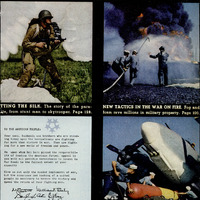 Popular Science Monthly, v. 146, n. 6, 1945
Popular Science Monthly, v. 146, n. 6, 1945

